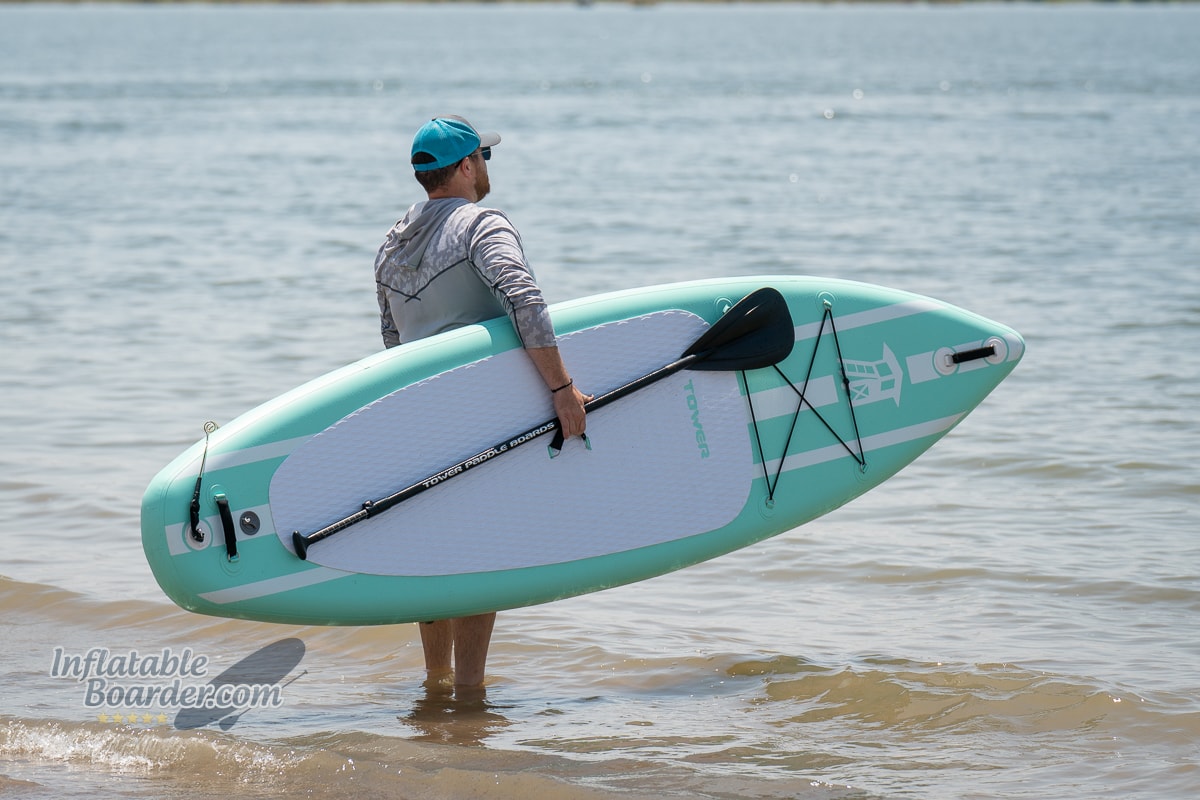
Tower Mermaid iSUP: Overview
The Tower Mermaid iSUP is an all-around paddle board that focuses on durability, simplicity, and maneuverability. While the Mermaid does come with a basic kit of accessories, it still leaves new paddlers without a leash or bag – something that does not frequently happen at this price point. The Tower Mermaid does share the exact same construction, size, shape, and kit as the Tower Adventurer 2 and the Tower Yachtsman.
— iRocker All Around 10’ Summary Ratings and Review —
Tower Mermaid iSUP Review
-
Construction & Durability
-
Features and Versatility
-
Stability
-
Speed
-
Maneuverability
-
Tracking
Overall Score
The Tower Mermaid is a basic all-around iSUP with a minimal kit, but struggles in some performance categories
Pros
- Durable and rigid construction with double-layer hand-glued construction
- Simple fin system with unique hook-and-pin system
- Diamond pattern deck pad is comfortable and grippy
- Highly maneuverable
- 2 year warranty for the board
Cons
- The board shape could be improved for better stability
- The value proposition could be improved with the inclusion of a bag and leash
Construction and Durability
The Tower Mermaid is part of Tower’s “Premium” line of boards that use a double-layer hand-glued construction.
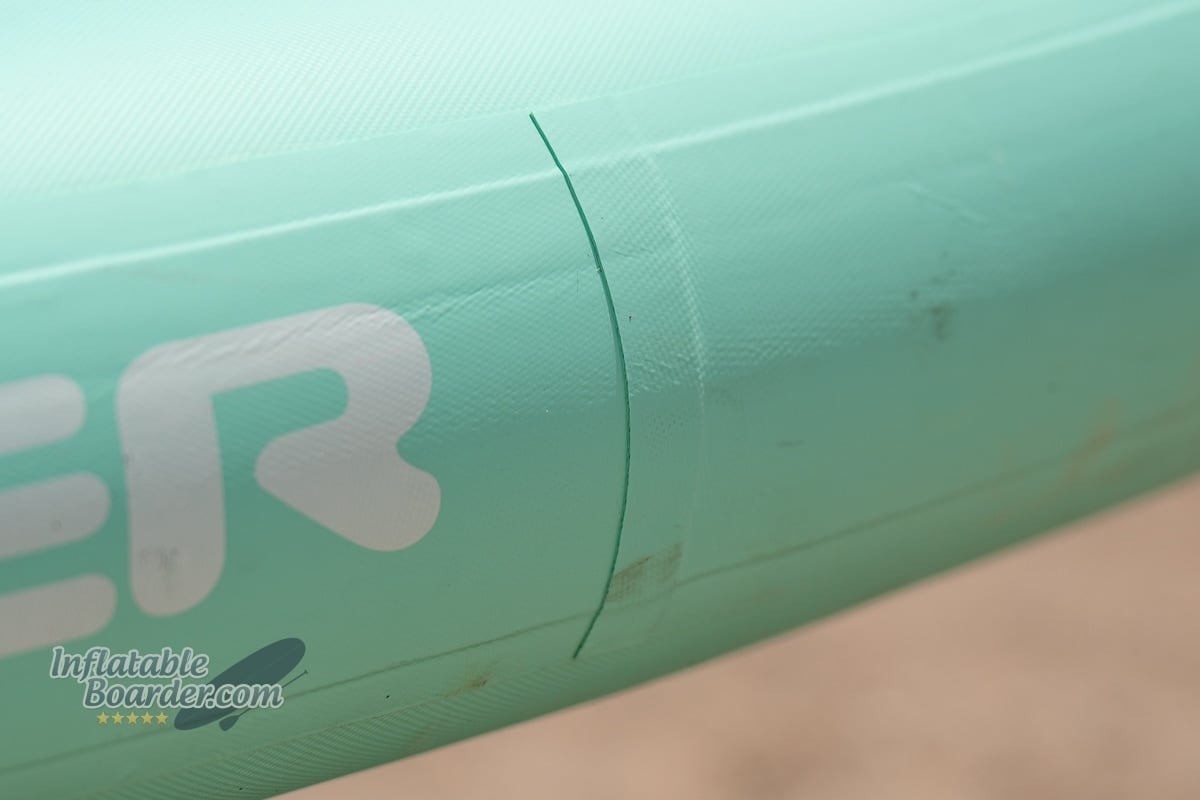
The Mermaid begins with a knitted fabric base for the deck and hull that are connected together with thousands of drop stitch space yarns. These yarns set the thickness of the board (6”) and keep it flat when inflated rather than rounding like a balloon. The fabric material has a PVC coating applied to it directly to make the material air tight and provide some rigidity.
Then a second layer of reinforced PVC tarpaulin is hand-glued to the first layer of PVC. This process adds significant time and labor to the process and weight to the board versus machine laminating. However, that additional weight and material does help significantly increase the board’s rigidity.
Once the second layer of material is applied, the top and bottom of the board are brought together and a layer of PVC material is hand-glued around the entire board. This first rail layer creates the airtight chamber for the board. A second, wider, strip of PVC is then glued over the first to help protect the inner seam and provide additional rigidity.
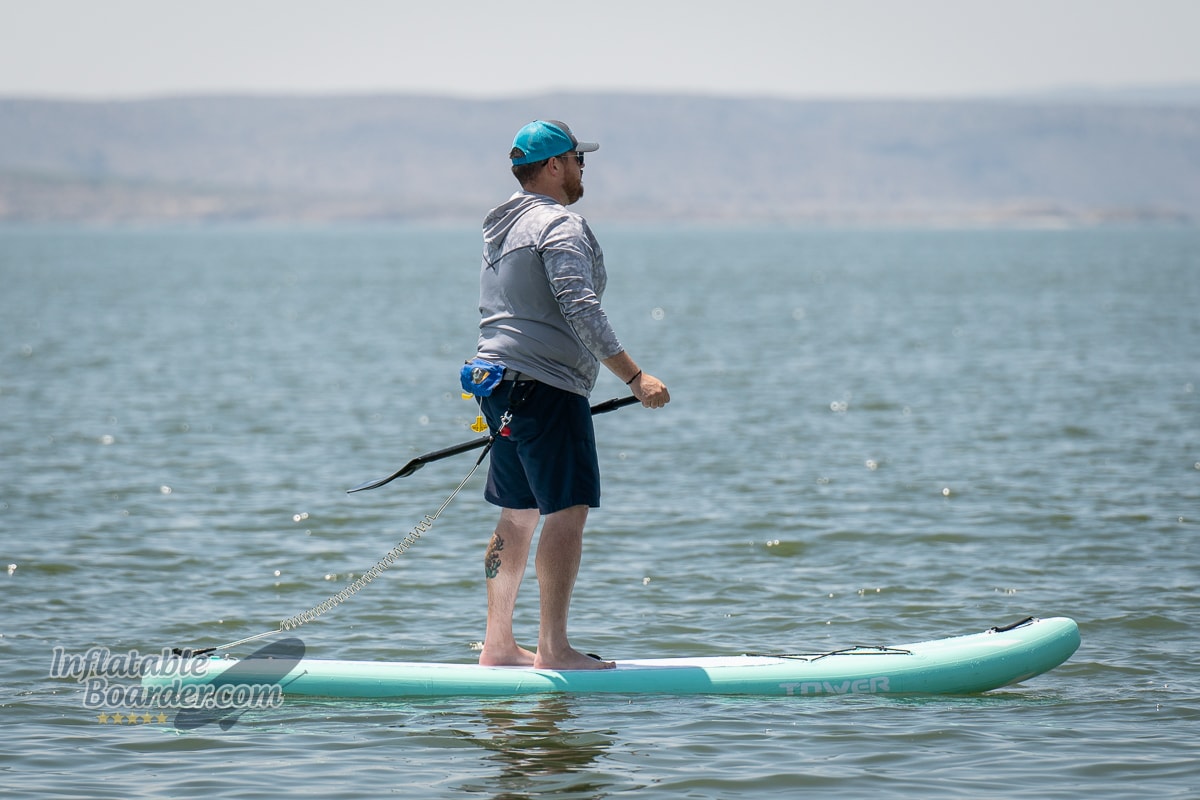
In our static bend test we load the board with 170 lbs of weight across a seven foot span and measure how much it bends. The Mermaid did moderately well bending 1.73”, but came out with slightly more flex than our running average of 1.57”. I was actually surprised by this result as Tower does not recommend using more than 12 PSI internal pressure for “optimal performance.” Tower is actually the only company we’ve tested so far that recommends such a low pressure. The vast majority of modern iSUPs recommend a maximum of 15 PSI, and many are capable of regular use at 15-20 PSI. Our testing has indicated that there are substantial gains in rigidity between 15-20 PSI, and I’m confident that the Mermaid would see similar gains if Tower were to recommend even just a 15 PSI maximum pressure.
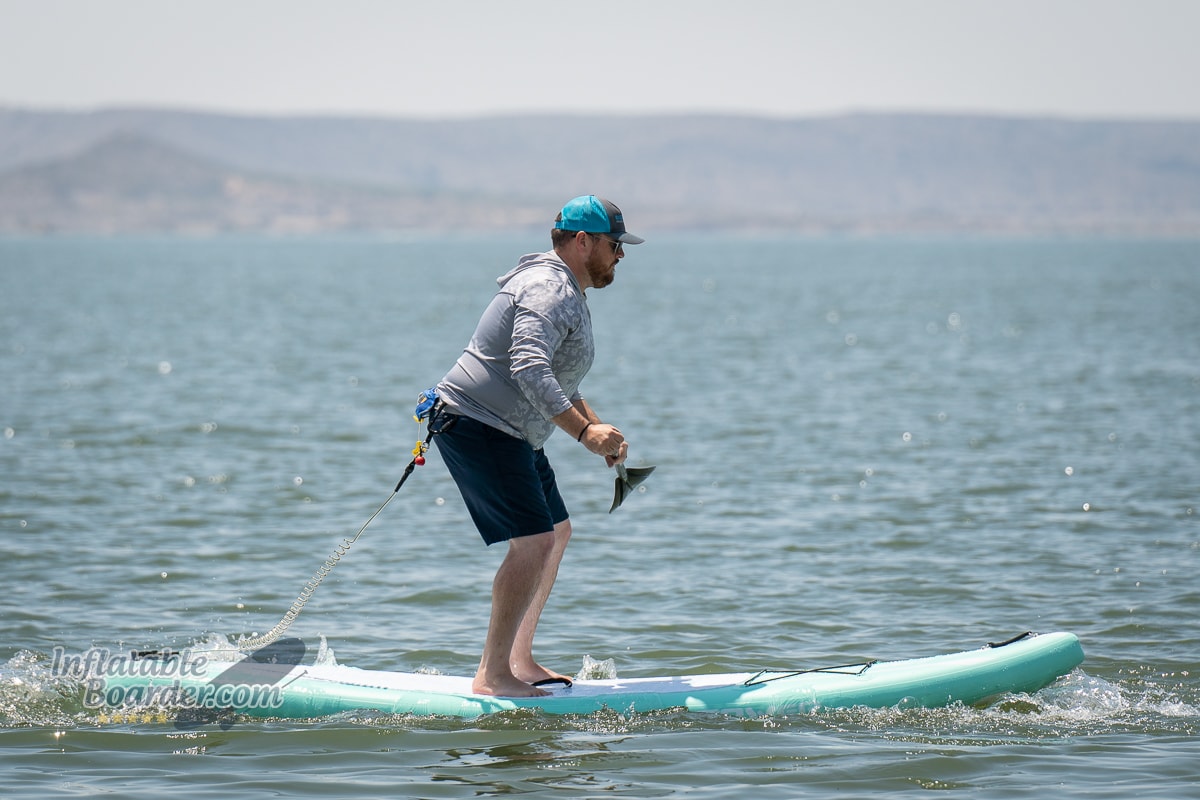
While the bend test gives us a number, what really matters is how the board feels on the water. While simply standing on the Mermaid or paddling casually I didn’t notice any flex. However if I progressed beyond that I did notice progressively more flex in the board. Faster/harder paddling generated more flex in the board the more effort I put into the stroke (even without going to a full sprint). I could take gentle steps on the board with minimal vibrations, but quick/large steps, hops, or jumping did produce some significant flex and vibration. The vibration had a tight feeling to it rather than a smoother, softer feel. Again I feel that a higher pressure, even just 15 PSI would really improve the flex profile of this paddle board.
Specifications
| Dimensions | |
| Length | 10’ 4” |
| Width | 32“ |
| Thickness | 6“ |
| Weight | |
| Max Capacity | 400 pounds |
| Board Weight | 25 pounds |
| Kit Weight |
31 pounds |
| Buying Info | |
| List Price | $ |
| Warranty | 2 years |
| Returns period | 30 days |
Features, Accessories and Versatility
The Mermaid, like all of Tower’s iSUPs, is quite minimalist. There’s just enough to get you out on the water for a few hours at a time. Though paddlers seeking more versatility, capacity, or other customization options are left a bit wanting.
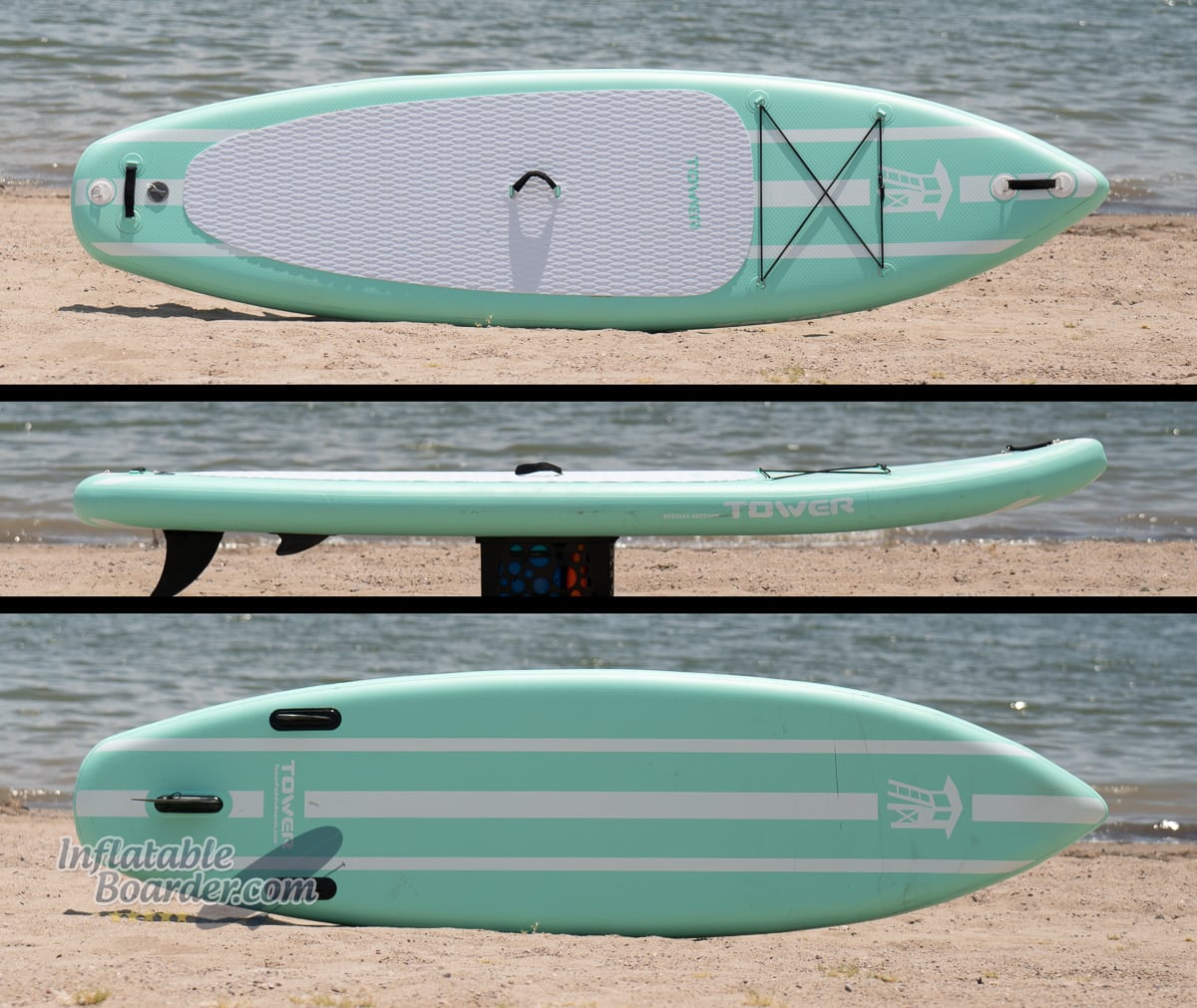
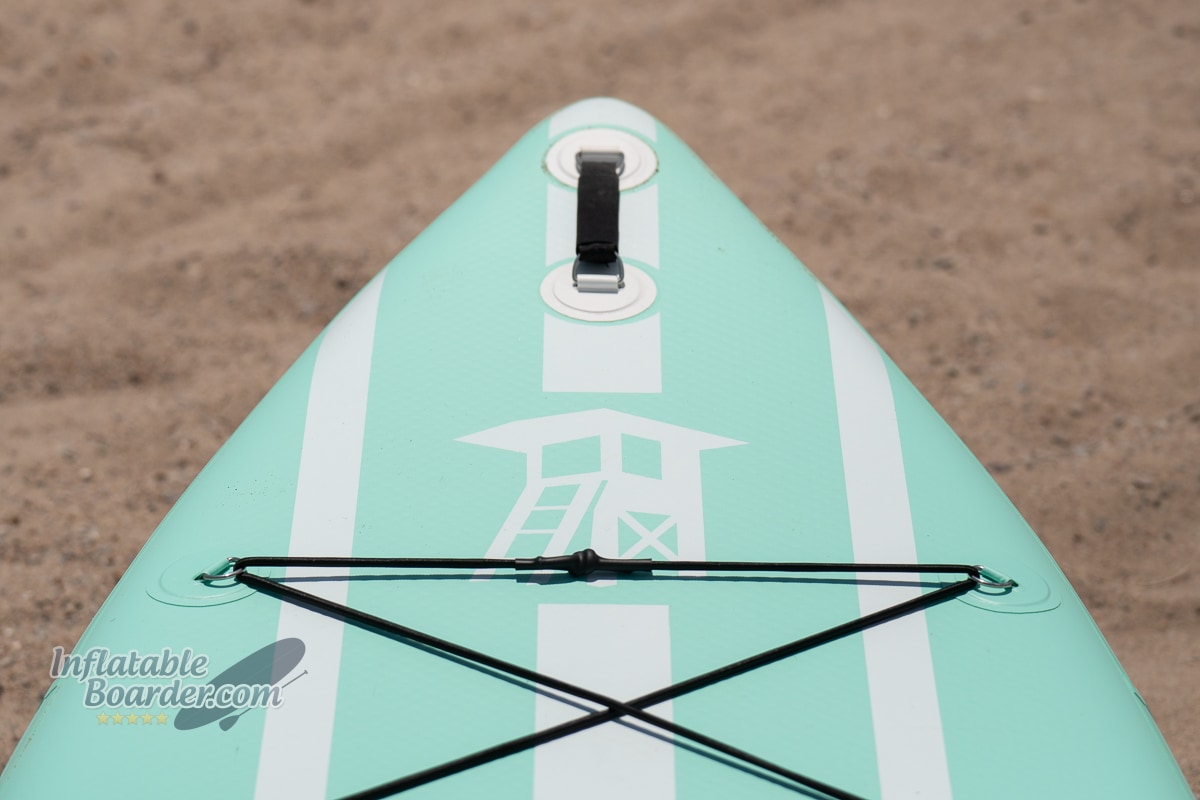
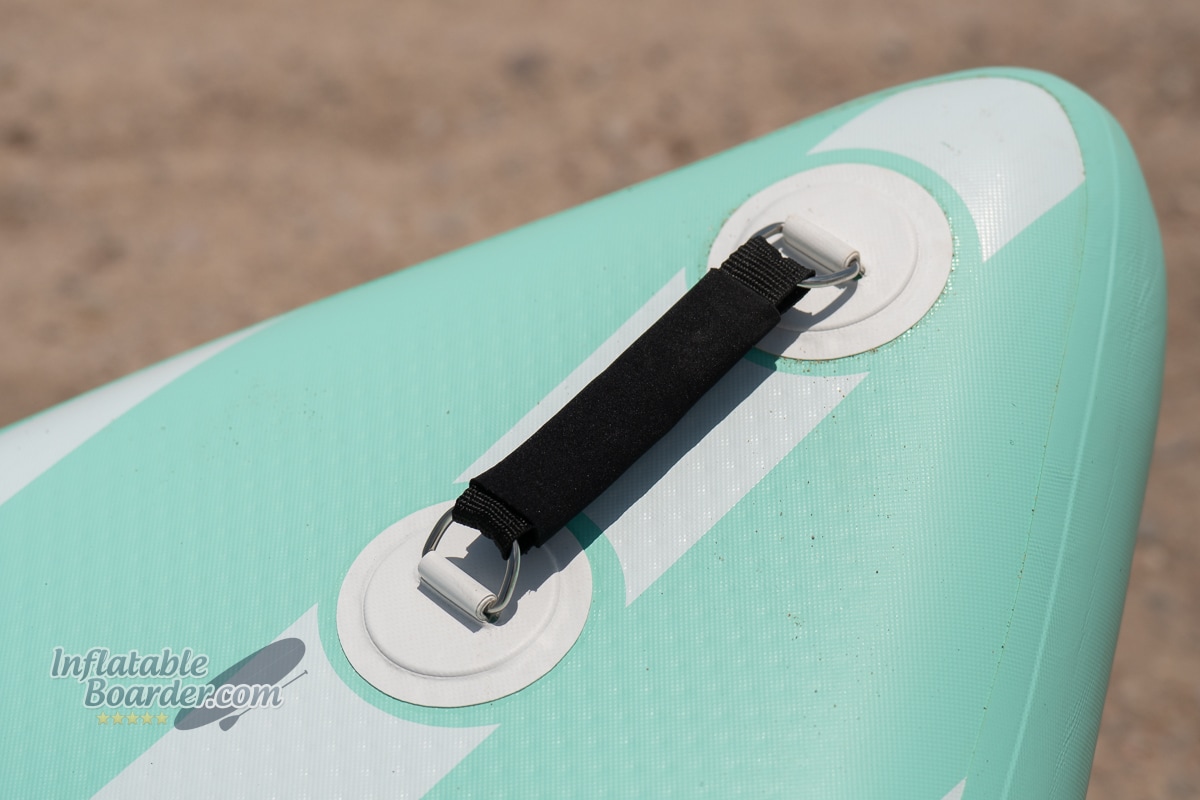
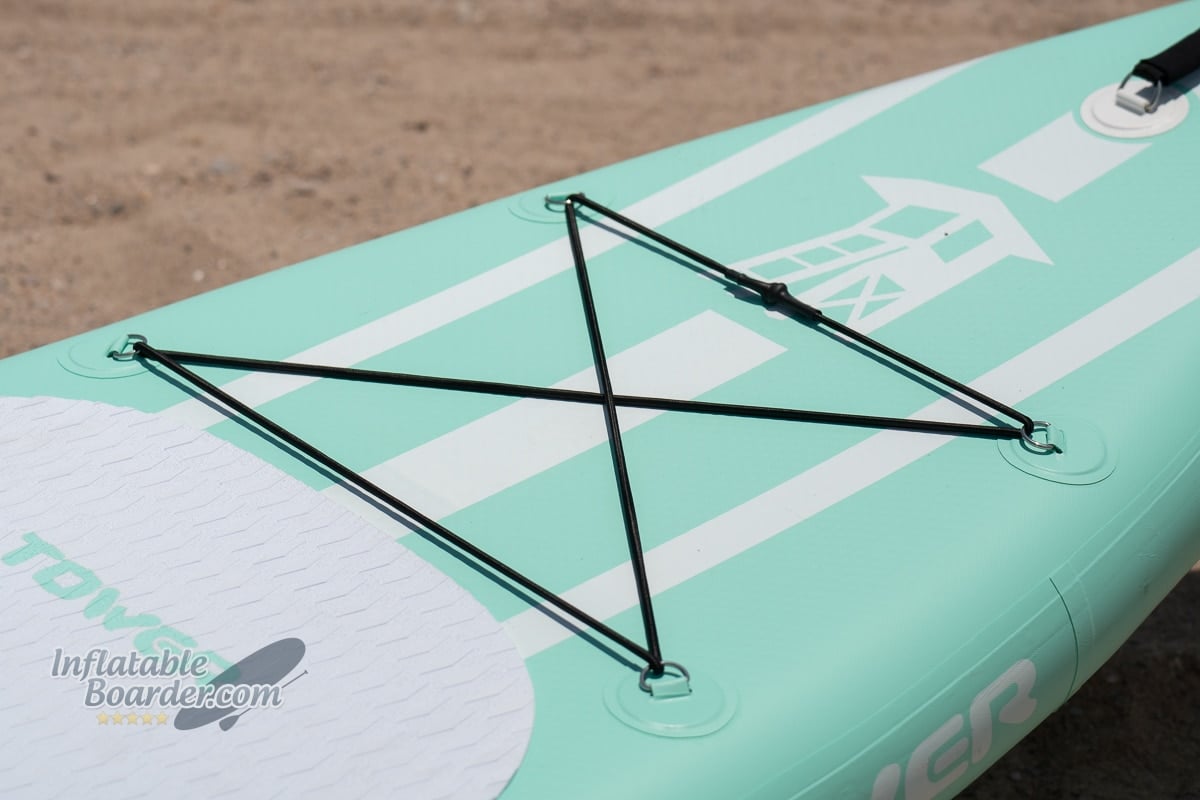
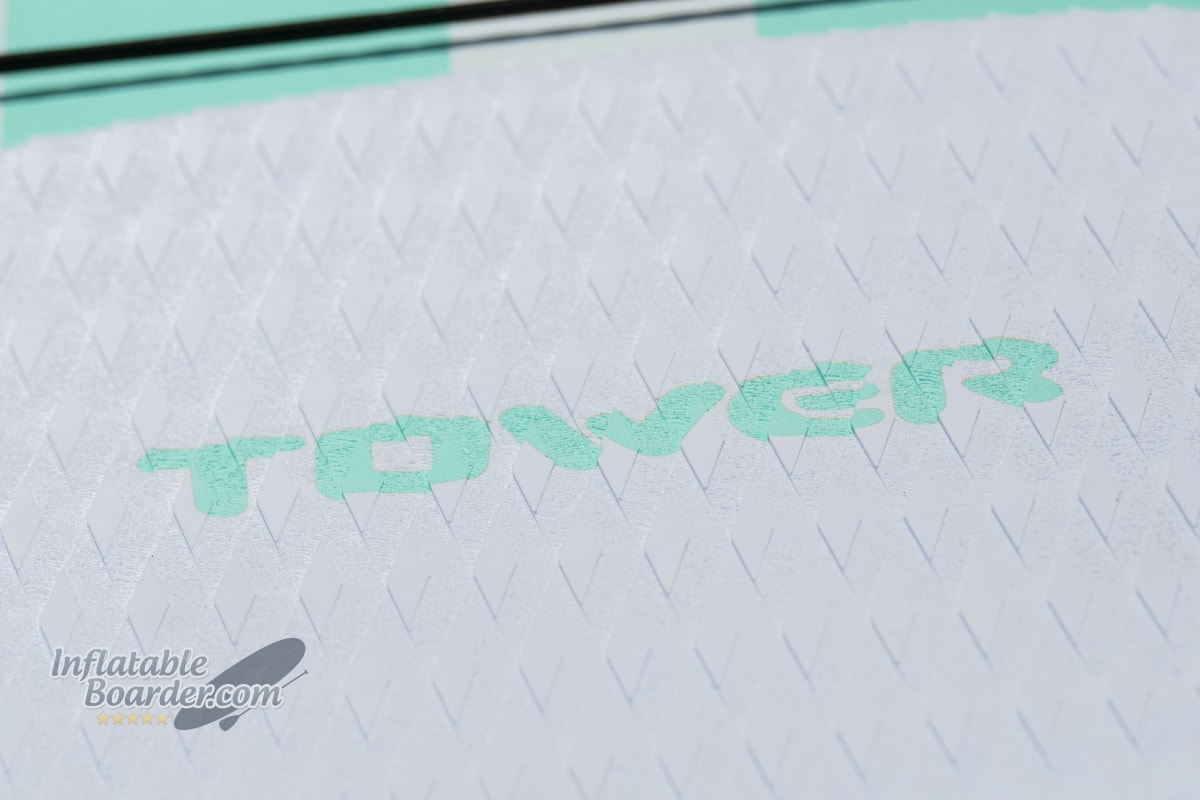
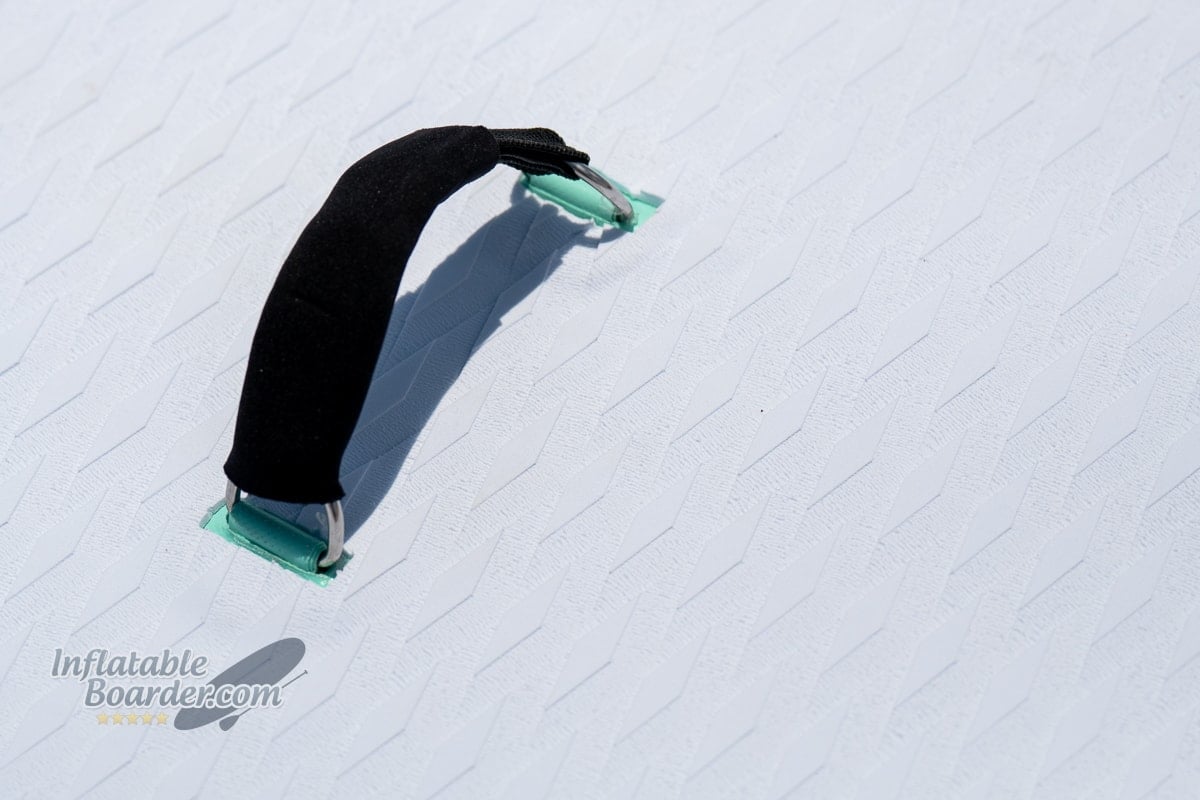
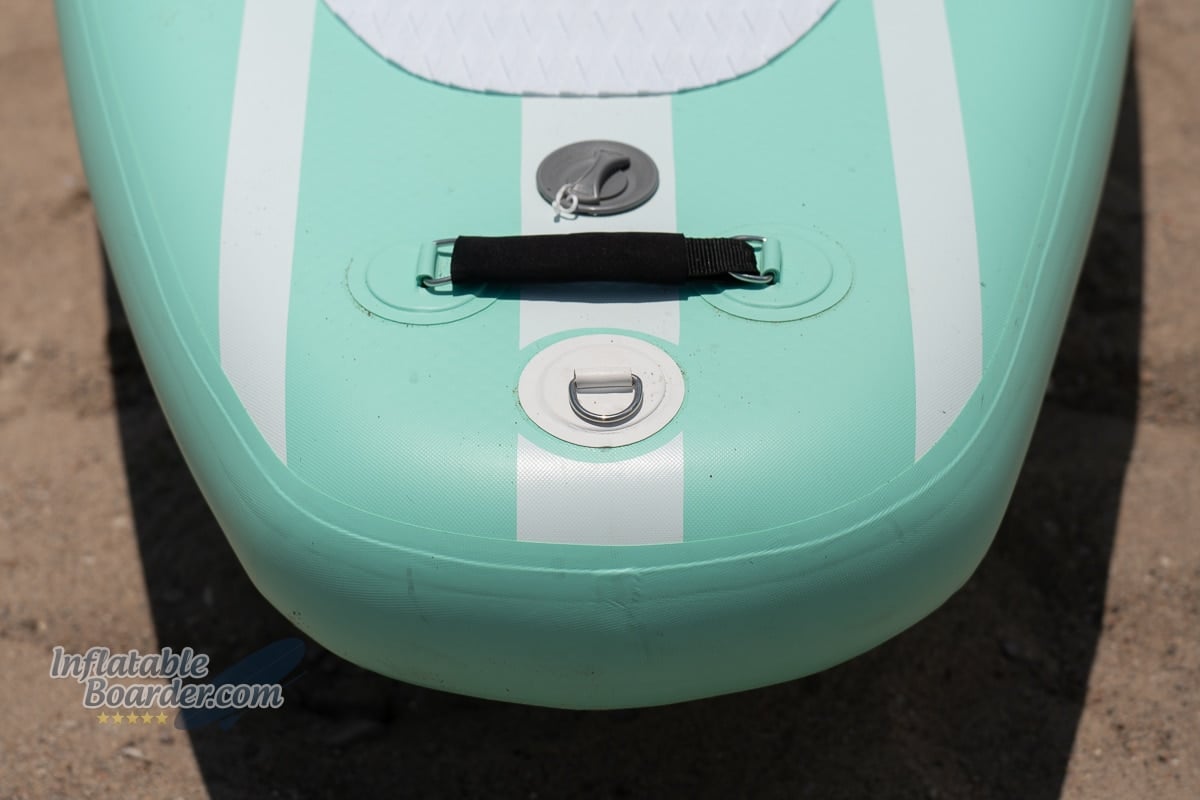
There is an overall lack of deck features on the Mermaid compared to many similarly-priced all-around iSUPs. That’s not necessarily a bad thing as not all paddlers need or want various types of accessory mounting points or large amounts of cargo space. The Mermaid does have everything you need for a casual cruise on the water, but no options otherwise limiting its overall versatility.
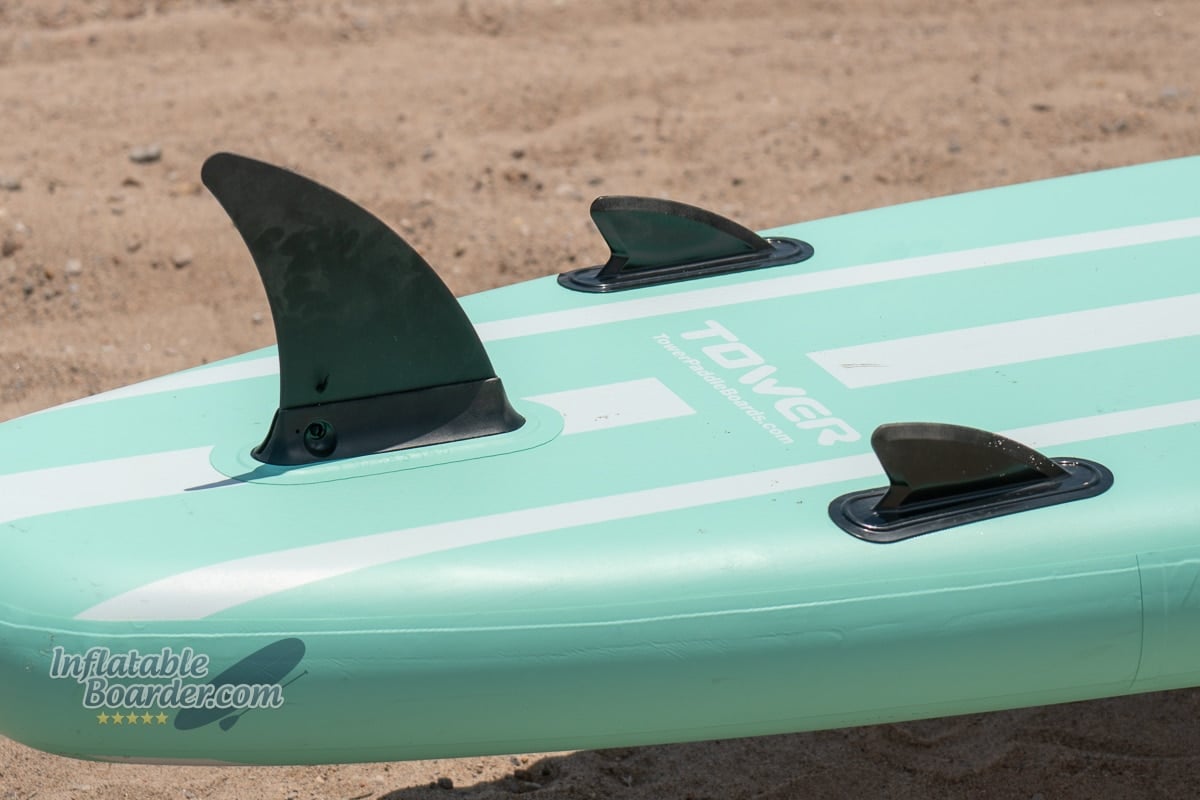
The Mermaid does come as a kit, but it’s not a very robust one. In addition to the board you get the removable 9” fin, a fiberglass/plastic paddle, repair kit, and a low-pressure single chamber, single action hand pump. The pump does not have a built in pressure gauge, but rather ships with a separate gauge that must be connected manually between the hose and pump. The hand pump is only rated to 14.5 PSI (and the gauge also only reads to a maximum 15 PSI), which tracks with Tower’s insistence that the Mermaid only needs 12 PSI for “optimal performance.” With a single action pump, inflation times are longer as the pump will not push air into the board on the up-stroke while the board is at low pressure.
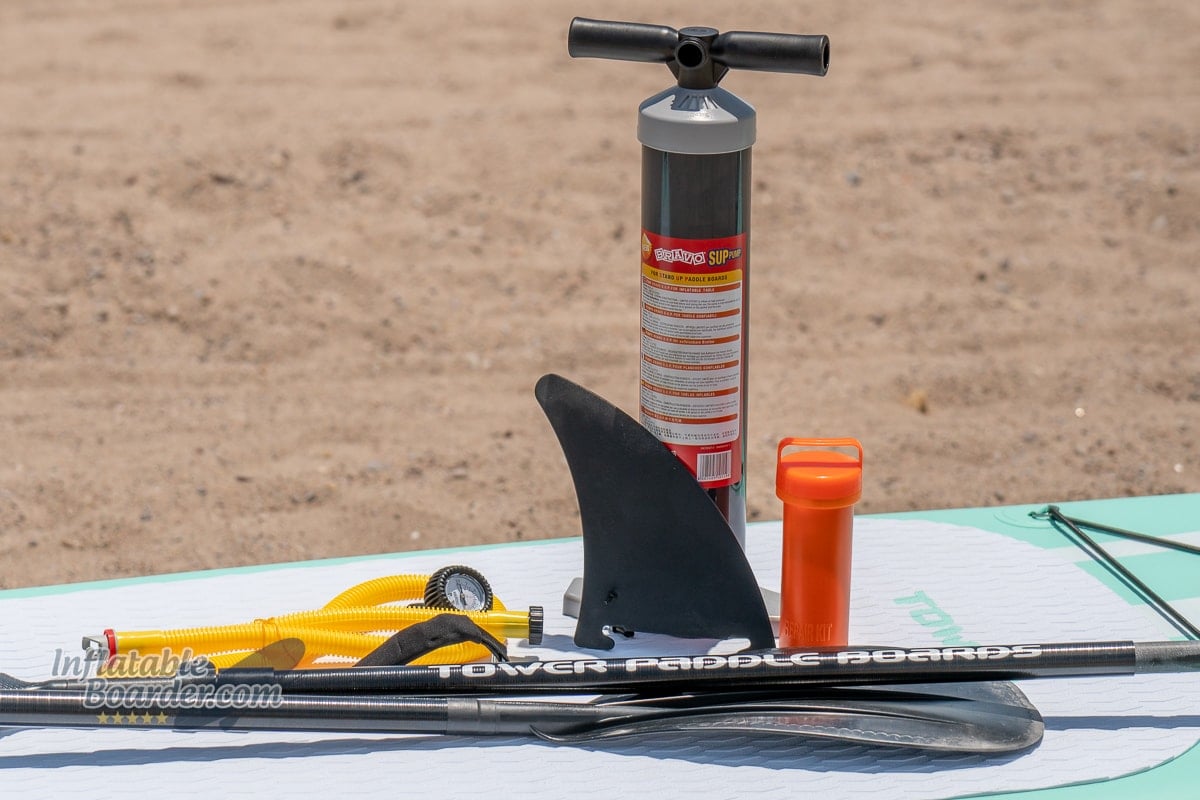
Paddle
The Tower fiberglass paddle is a step up in comfort from an aluminum paddle, but only just. As far as composite paddles and kit paddles go, it’s one of the heaviest I’ve encountered and has a significant amount of flex during use.
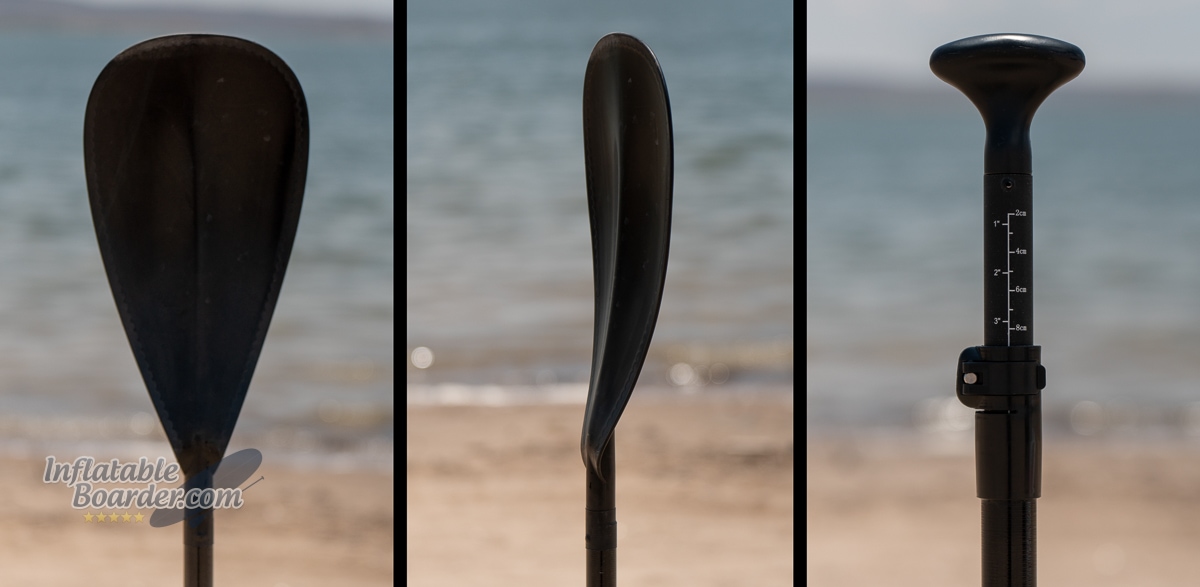
At 34.1 ounces / 967 grams, the Tower fiberglass paddle is very heavy – the second heaviest non-aluminum paddle I’ve tested. Part of that weight comes from the large ABS plastic paddle blade. Large paddle blades are typically best for large paddlers. However, with the significant amount of flex in both the blade and the fiberglass shaft the large blade doesn’t produce as much torque as its surface area might indicate, and is relatively comfortable to use even for smaller paddlers. That same flex, though, means that it is much more difficult to produce larger amounts of power for heavier paddlers, paddling with a heavy payload, or paddling with a passenger.
Composite fiber paddle shafts (fiberglass, carbon fiber, and others) can be made and finished in a variety of different ways for different effects and textures. This particular shaft is quite flexible and has a “cello-wrap” finished (named for the cellophane wrapping used during the curing process). This leaves a series of ridges on the shaft that, depending on the finish, can be quite deep. I did find that the finish on this particular paddle offered lots of grip, but at the same time did begin to rub my hands after an hour or so of paddling.
The adjustment clamp is easy to use and to tighten if necessary (by simply twisting the clamp handle) and the handle section does have length markings. There is no indexing mark or groove, though, so you will need to double check that your handle grip and paddle blade are properly aligned after any adjustment. The grip itself is made of a lightweight plastic, similar to many other kit paddles in this price range, that can sometimes feel soft in your hand, but otherwise fits comfortably.
Stability
The Tower Mermaid has plenty of volume, rigidity, and the right specified sizing for a beginner-friendly iSUP, but the overall shape of the board significantly reduces its stability in anything other than very flat conditions.
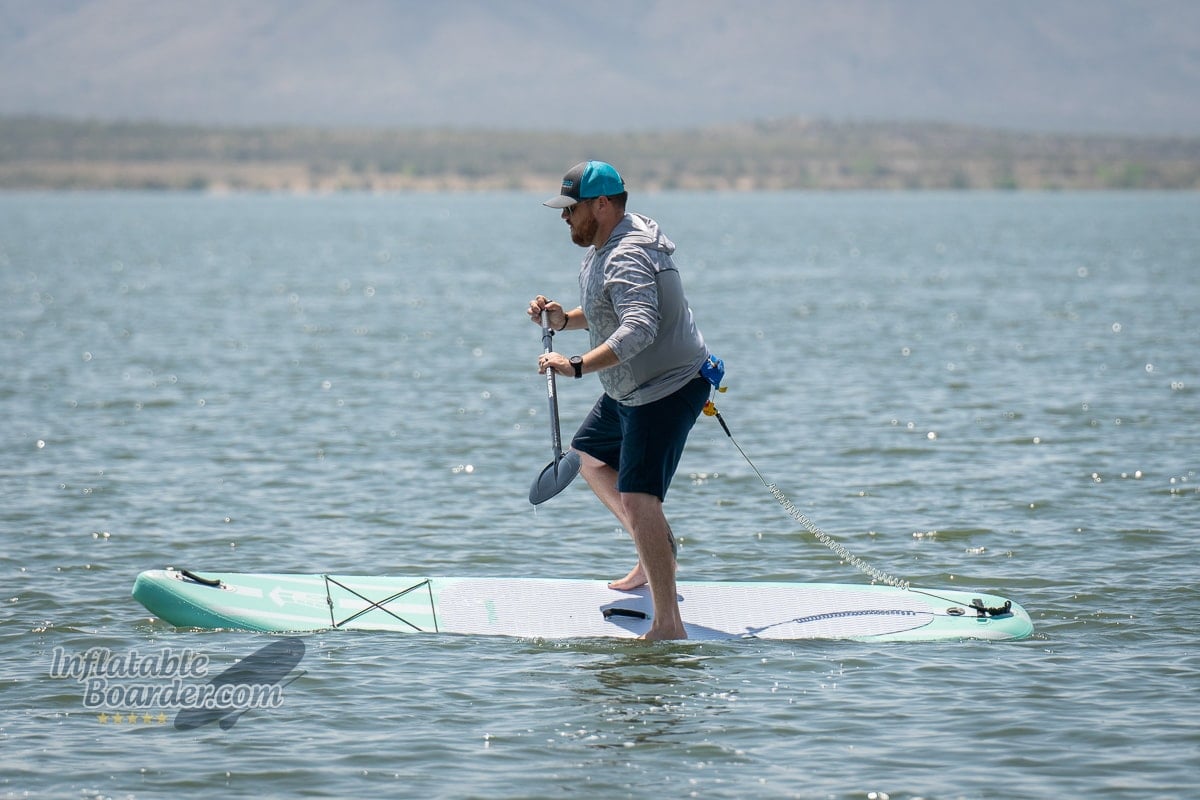
Paddle board shaping is rife with trade offs and compromises at every angle. Because of that, the shape of the board itself makes a huge difference in performance aspects between boards of the same length and width. The Mermaid has what I refer to as a “torpedo” shape. There is a pointed nose with a continuous arc to a medium-to-narrow rounded tail. Where those curves draw in, and how quickly, makes a huge difference in the board’s handling. In this case, the mid section of the board does measure 32” wide, but it’s only 32” wide for a very small area right at the middle of the board. This does a couple of things to the board’s stability.
First, if you are standing anywhere than right at that specific wide point, you are now standing on a narrower board. Second, even if you are standing at the widest point of the board, there is less surface area on the water and less board volume in front of and behind you. General, the more contact area a paddle board has, the more stable it will feel.
While paddling the mermaid in very calm, flat conditions I didn’t have any issues with stability while standing or paddling. However while I had the Mermaid on the water in mildly windy/choppy conditions (still under 10 MPH wind), it became far, far less stable. At the same time I was able to compare a similar size board (10’6” x 32”) that had a far more parallel shape through the middle of the board. Even though that board was significantly less stiff it felt far more stable in those conditions than the Mermaid.
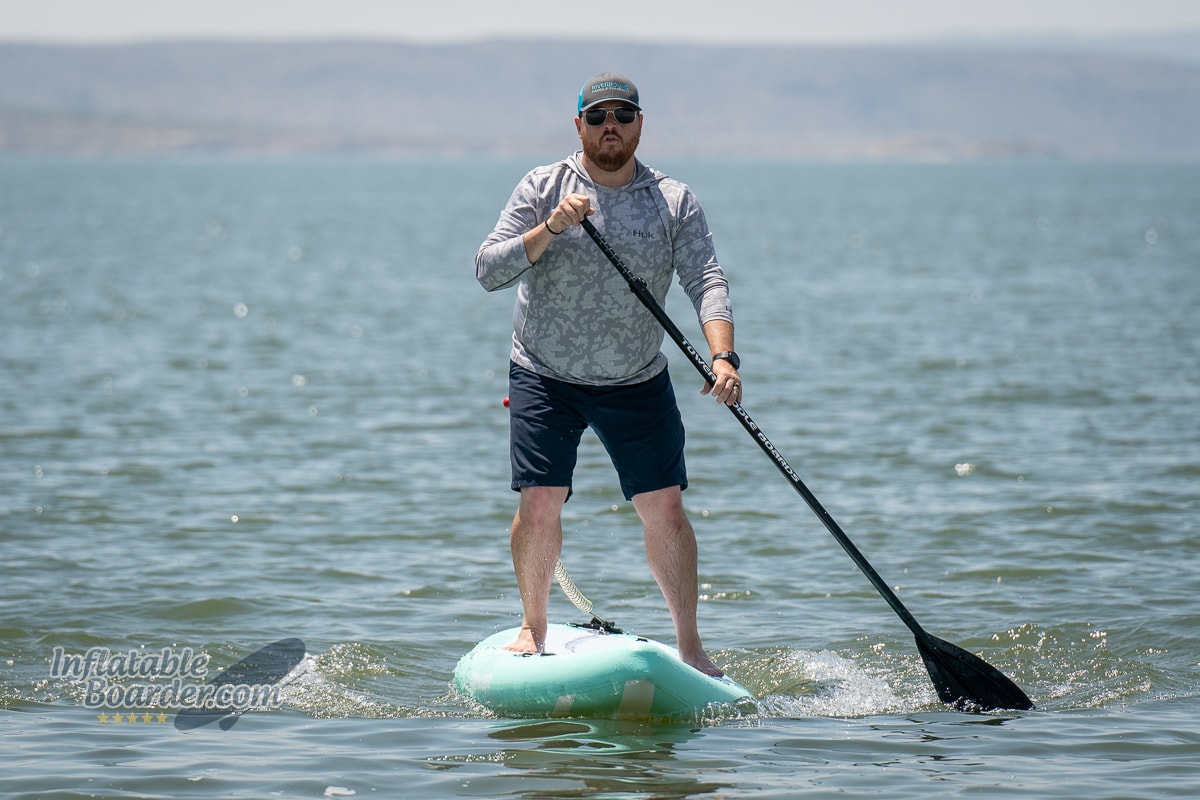
How stable a board feels when it is not flat on the water is called its secondary stability. Secondary stability is very important for beginner paddlers as they tend to wobble side to side more than an experienced paddler, especially in choppy conditions. The torpedo shape with its heavy tapers also means there is less surface area and volume in contact with the water when the board is on its edge, resulting in lower stability. While paddling directly into any directional waves/wake, the Mermaid did not have any excessive rocking from side to side, but if the waves or wake come from any other angle the board does roll easily.
Walking around on the board in very calm conditions was relatively easy. There was some flex and vibration, but not so much to impact stability. Sinking the tail and lifting the nose for a pivot turn was relatively easy, though there is no tactile feedback on the deck pad to let you know when you are reaching the end of the pad. In the mildly choppy conditions it was far more difficult as the stability of the board significantly decreased with each step back toward the tail.
Speed
The Tower Mermaid is made more for casual cruising than for top speed, and our test results confirm that with good cruising speeds and efficiency, but low top-end speeds.
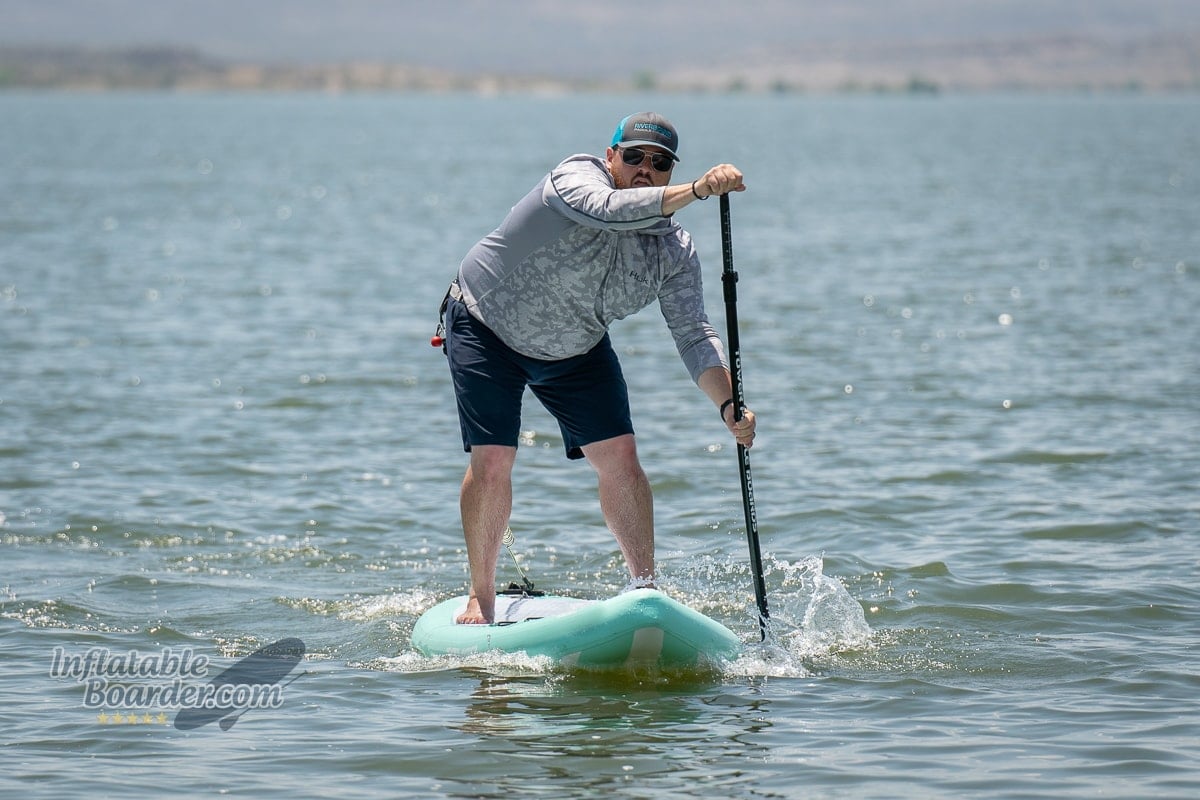
The Tower Mermaid is not a board built for high speed. The flex of the board and flex of the paddle combined with the board’s overall length and shape are just not conducive to paddling fast. The average sprinting speed I was able to achieve with the Mermaid was just 4.9 MPH (7.8 KMH) and my peak top speed was just 5.1 MPH (8.2 KMH). But, like I said, this is not a board designed for high-speed paddling.
The Mermaid did significantly better in our cruising and efficiency testing. While paddling at a casual pace of 25 strokes per minute (taking a slight pause between easy, continuous strokes) the Mermaid averaged a great 3.5 MPH (5.6 KMH). That is on the faster end of cruising speeds for all-around iSUPs. I feel that the larger paddle blade performs much better at this casual pace than it does at a sprinting cadence.
We test a paddle board’s efficiency in the water by measuring how far it glides between paddle strokes without slowing down. The Mermaid traveled an average of 16.5 feet per stroke, or 1.6 board lengths. This puts the Mermaid’s efficiency scoring right around the midpoint for similar-size all-around iSUPs.
Maneuverability and Tracking
The Mermaid excelled in our maneuverability testing, but could use some improvement in its tracking ability.
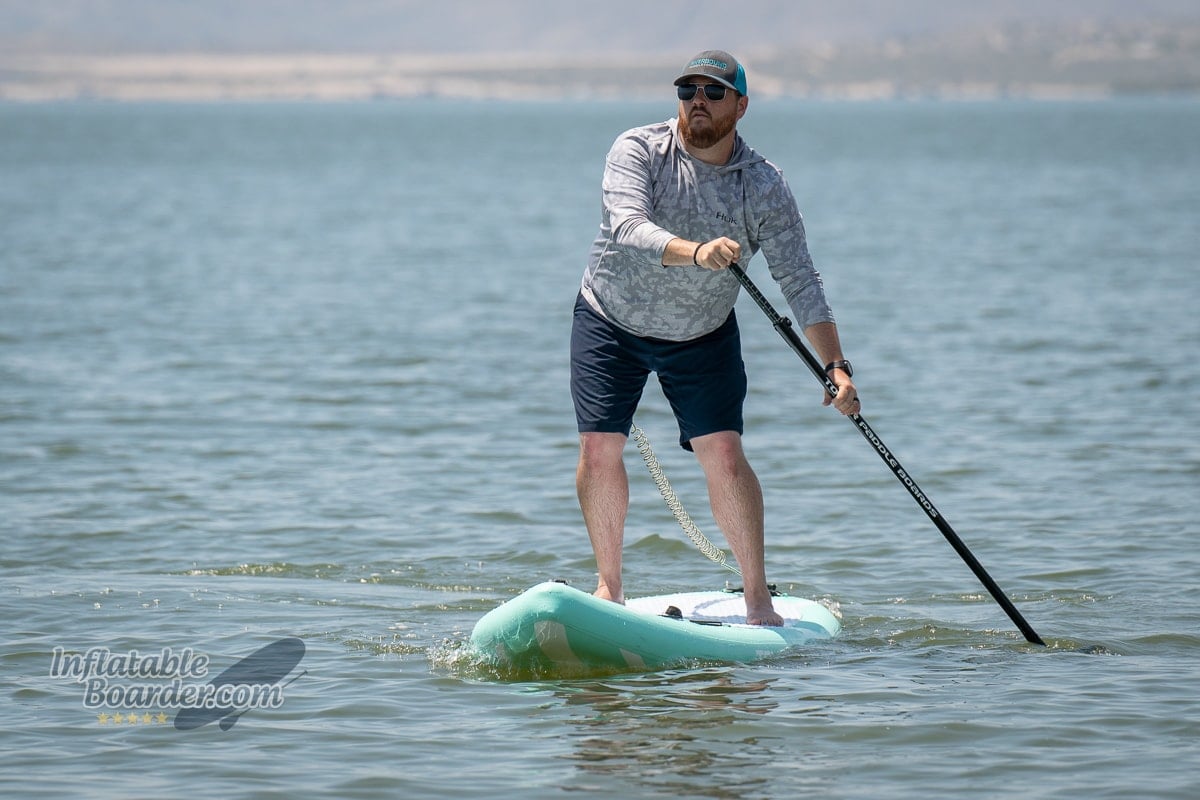
Shorter boards and boards with less fin surface area will generally maneuver much easier on the water than longer boards or with more/larger fins. The Mermaid is 10’4” long, but with its rocker profile has closer to 9’6” of board on the water. While the Mermaid does technically have three fins, we have found that the use of very short fixed plastic fins on the side of the board has little actual impact on the maneuverability, tracking, or stability of an iSUP. With essentially a single center fin and this shorter length, the Mermaid made quick work of our maneuverability test by turning a full circle in an average of just 4.5 forward sweep strokes. These forward sweeps are usually not the most efficient way to turn your paddleboard, but are one of the most basic methods to use without reducing forward momentum.
By reversing the stroke (cleverly called a reverse sweep stroke) and paddling in an arc from the tail to the nose you do lose any forward momentum, but turn the board much more quickly. The Mermaid makes the same 360° turn in an average of just 3.25 reverse sweep strokes.
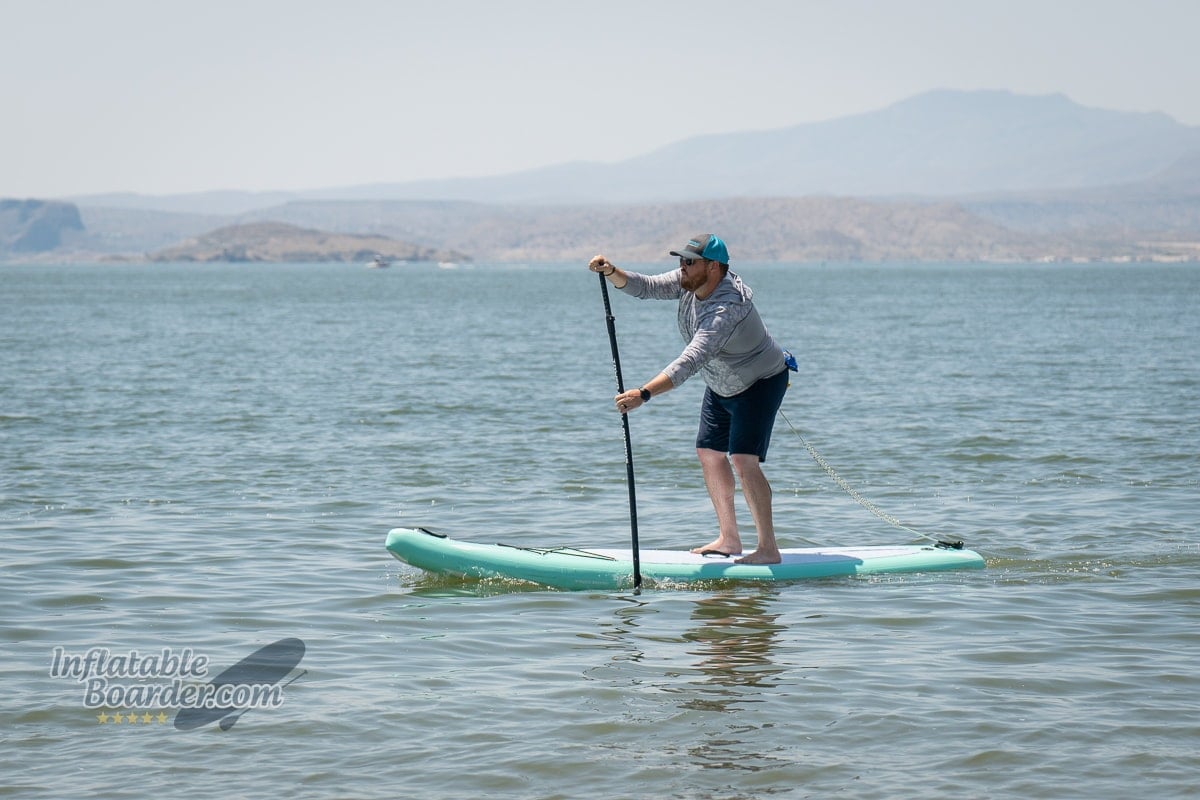
Maneuverability and Tracking are often two sides of the same coin, and this is definitely the case with the Mermaid. In our 10-stroke tracking test we paddle toward a distant target and once “on course” take 10 strokes on a single side. Then we measure the difference between the new course and old course using a compass. The Mermaid, in calm conditions, deviated an average of 25° off course in just 10 strokes while trying to paddle as straight as possible. That is a significant deviation, even for boards of the same size.
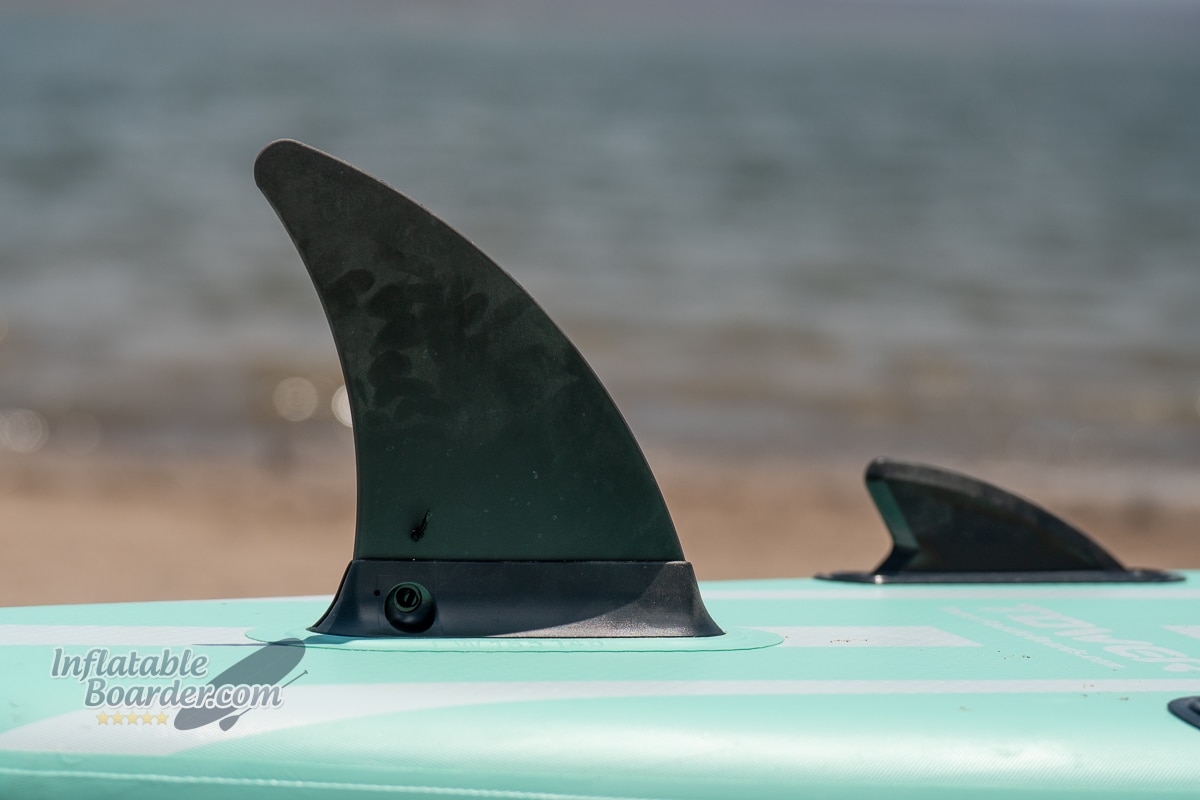
The Tower Mermaid technically has three fins – a removable center fin and two fixed side fins. In our experience and testing we’ve found that these small fixed side fins make no real impact on performance, but are purely aesthetic. Larger, removable, side fins can impact maneuverability, tracking, and even stability, but they are much larger than these permanent fins.
The removable center fin is 9” long and has a thick fin shape. There’s significantly more surface area at the base of the fin than there is at the tip – a design that allows for higher maneuverability, but less tracking.
The hook-and-pin attachment system is pretty unique. I believe a few other brands used this (or a similar) system many years ago, but have since moved away from it. It’s a relatively easy system to use, but relies entirely on the split, pressure-fit plastic pin to hold everything in place. That does give me overall durability concerns. Additionally these fins are hard to find replacements for (other than directly through Tower) and have very little options for different shapes or sizes. Tower only sells this 9” version and a 4.5” “river” fin of the same shape.
Warranty and Customer Support
Tower Paddle Boards warranties the Mermaid and their other “Premium” line iSUPs for 2 years and offers no explicit warranty on any of their accessories. There is a 30-day return window for new/unused boards (less shipping fees). For all of Tower’s insistence on the quality and longevity of their “Premium” iSUPs on their website it’s a bit disappointing to see only a basic 2 year warranty (and none for the accessories). I would like to see them stand behind their product for longer and offer a 3+ year warranty (their “Elite” series iSUPs use the same construction and receive a 3 year warranty). If you have any questions, you can contact Tower via telephone, email, by appointment at their California retail shop, and through social media.
Overall Impressions/Review Summary
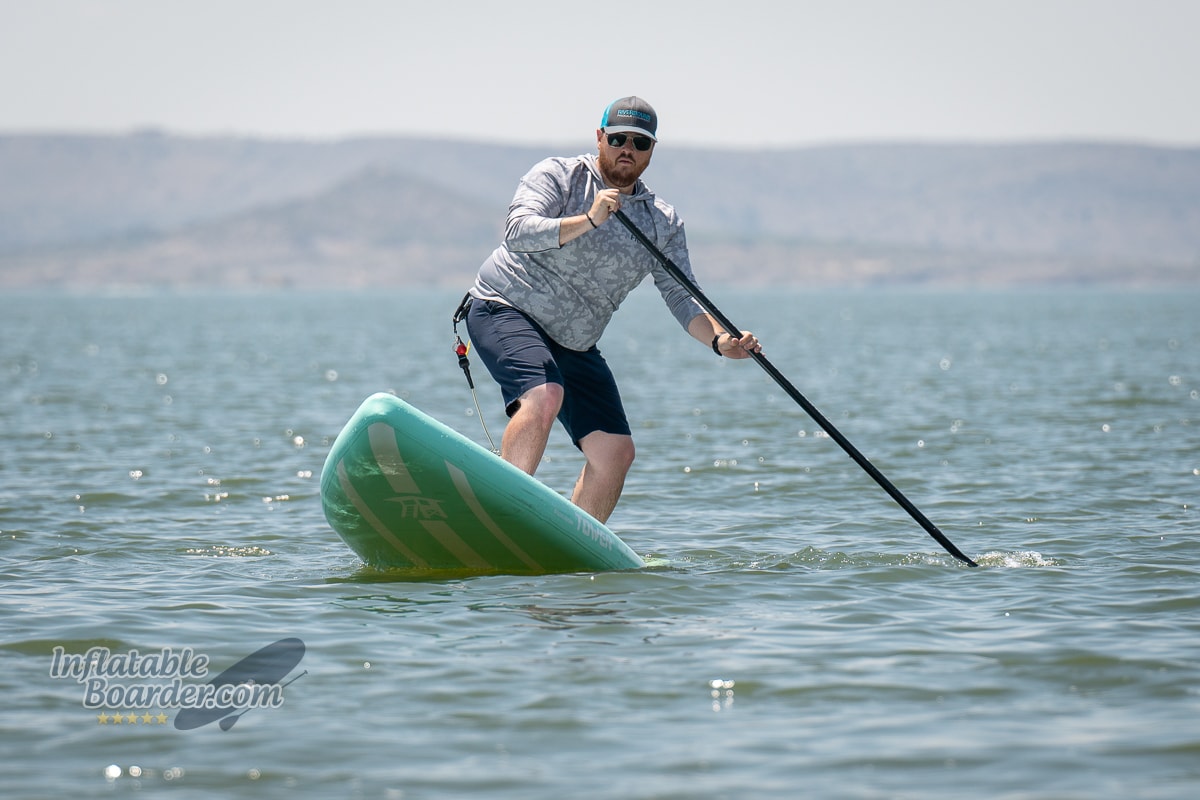
The Tower Mermaid all-around iSUP has some potential, but it is being held back by its shape and lower pressure recommendation. The included kit is also quite lackluster and not befitting the price tag, even at its current sale price (though I have never not seen it on sale for this price). The value proposition for this paddleboard versus many other direct to consumer brands is just not as high, and the performance shortcomings – particularly its stability – are hard to overlook. Hopefully we’ll see some significant changes to the Mermaid in the future.
Tower Mermaid iSUP FAQ
What is the difference between the Tower Mermaid, Adventurer 2 and Yachtsman?
There is very little difference between these three iSUPs. Essentially they are the same board with different color options. They share the same size, shape, and construction. The Yachtsman, though, does not have a cargo bungee.
What is the difference between the Tower Elite series, Premium series, and Starter series iSUPs?
The Tower Elite and Premiums series iSUPs share the same construction, but the Elite series are 8” thick and the Premium series are 6” thick. The Starter series uses a lighter weight material than the other two. Tower also adjusts their warranty based on the series, 3 years for Elite boards, 2 years for Premium boards, and 1 year for Starter boards. All three come with the same basic accessory kit.
Is the Tower Mermaid good for beginners?
The Tower Mermaid has some stability issues due to its shape. It also has a very basic accessory kit that does not include a safety leash. Due to these issues we do not consider the Tower Mermaid to be a best option for beginner paddlers.
How long does it take to inflate the Tower Mermaid iSUP?
With the single-chamber/single-action hand pump it takes about 8-10 minutes to inflate the Tower Mermaid to its recommended 12 PSI.
Can I use the Tower Mermaid with a kayak seat?
No, the Tower Mermaid is not compatible with kayak seat accessories.
Can I paddle with kids or pets on the Tower Mermaid iSUP?
Potentially, however, the overall shape of the board reduces its stability, especially when standing off center to accommodate a child or dog on the board as well.

